TOYOTA SUPRA 2022 Owners Manual
Manufacturer: TOYOTA, Model Year: 2022, Model line: SUPRA, Model: TOYOTA SUPRA 2022Pages: 498, PDF Size: 104.06 MB
Page 131 of 498
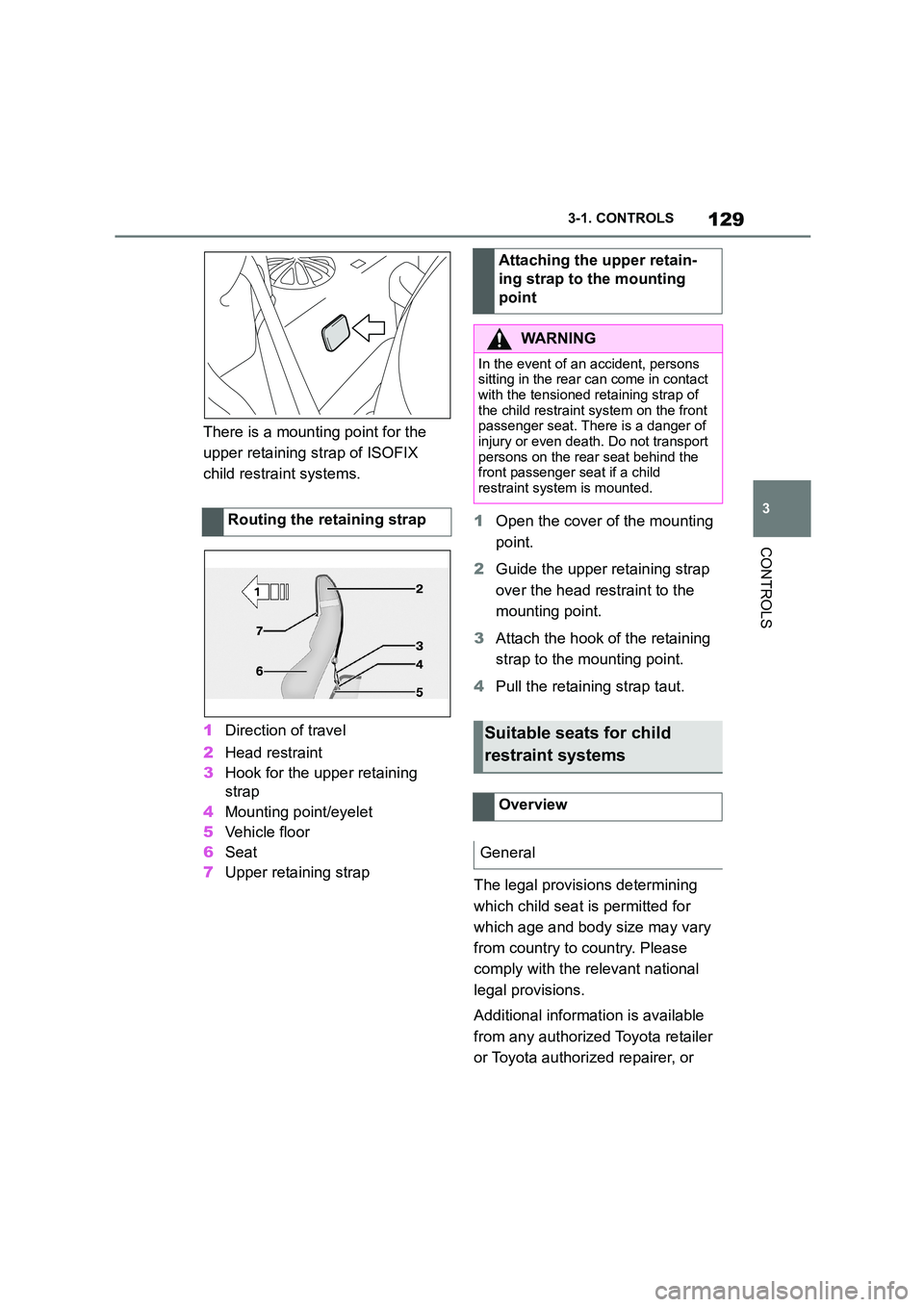
129
3
3-1. CONTROLS
CONTROLS
There is a mounting point for the
upper retaining strap of ISOFIX
child restraint systems.
1 Direction of travel
2 Head restraint
3 Hook for the upper retaining
strap
4 Mounting point/eyelet
5 Vehicle floor
6 Seat
7 Upper retaining strap
1 Open the cover of the mounting
point.
2 Guide the upper retaining strap
over the head restraint to the
mounting point.
3 Attach the hook of the retaining
strap to the mounting point.
4 Pull the retaining strap taut.
The legal provisions determining
which child seat is permitted for
which age and body size may vary
from country to country. Please
comply with the relevant national
legal provisions.
Additional informat ion is available
from any authorized Toyota retailer
or Toyota authorized repairer, or
Routing the retaining strap
Attaching the upper retain-
ing strap to the mounting
point
WA R N I N G
In the event of an accident, persons
sitting in the rear can come in contact with the tensioned retaining strap of
the child restraint system on the front
passenger seat. There is a danger of
injury or even death. Do not transport persons on the rear seat behind the
front passenger seat if a child
restraint system is mounted.
Suitable seats for child
restraint systems
Overview
General
Page 132 of 498
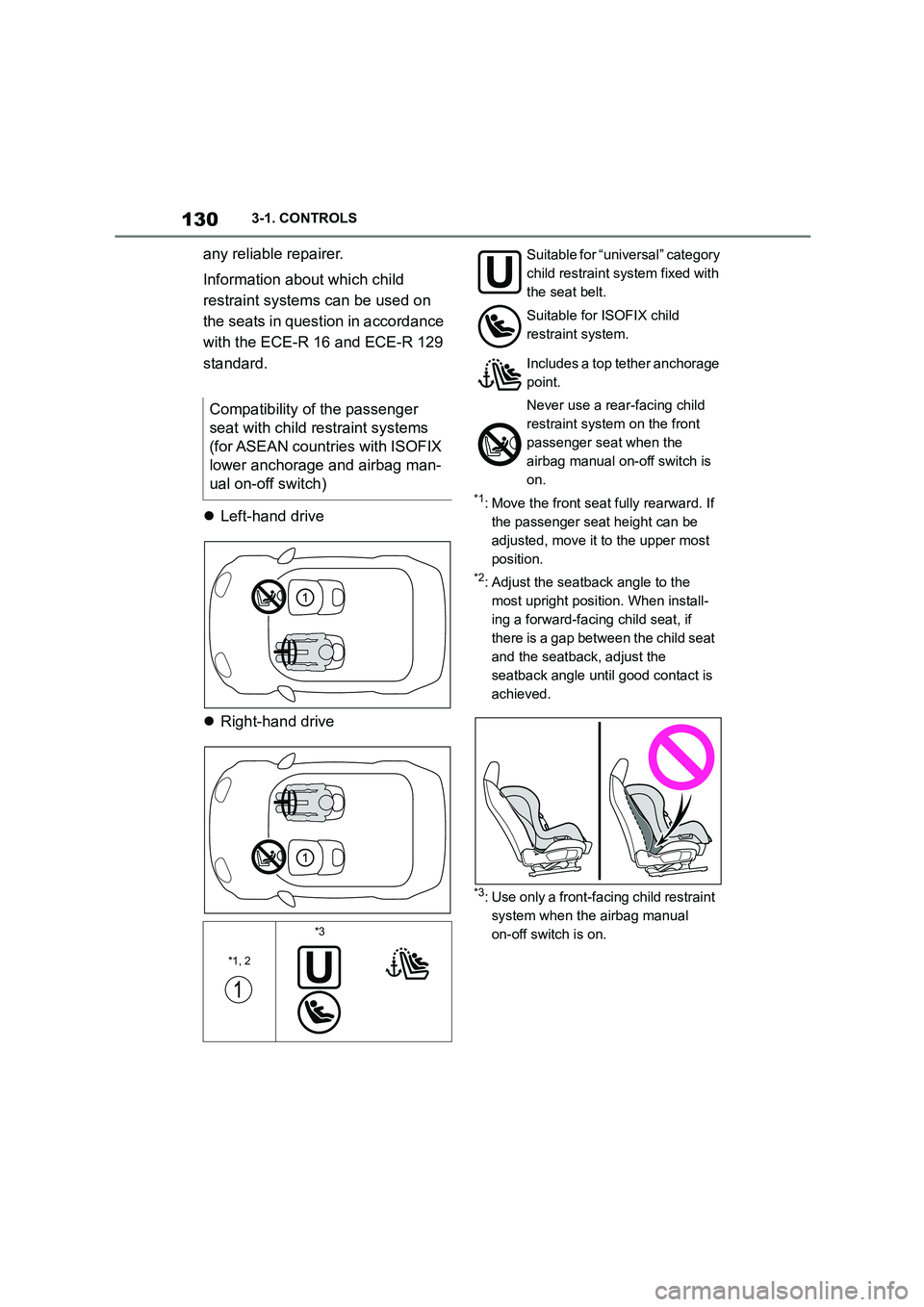
1303-1. CONTROLS
any reliable repairer.
Information about which child
restraint systems can be used on
the seats in question in accordance
with the ECE-R 16 and ECE-R 129
standard.
Left-hand drive
Right-hand drive
*1: Move the front seat fully rearward. If
the passenger seat height can be
adjusted, move it to the upper most
position.
*2: Adjust the seatback angle to the
most upright position. When install-
ing a forward-facing child seat, if
there is a gap between the child seat
and the seatback, adjust the
seatback angle until good contact is
achieved.
*3: Use only a front-fa cing child restraint
system when the airbag manual
on-off switch is on.
Compatibility of the passenger
seat with child restraint systems
(for ASEAN countries with ISOFIX
lower anchorage and airbag man-
ual on-off switch)
*1, 2
*3
Suitable for “universal” category
child restraint system fixed with
the seat belt.
Suitable for ISOFIX child
restraint system.
Includes a top tether anchorage
point.
Never use a rear-facing child
restraint system on the front
passenger seat when the
airbag manual on-off switch is
on.
Page 133 of 498
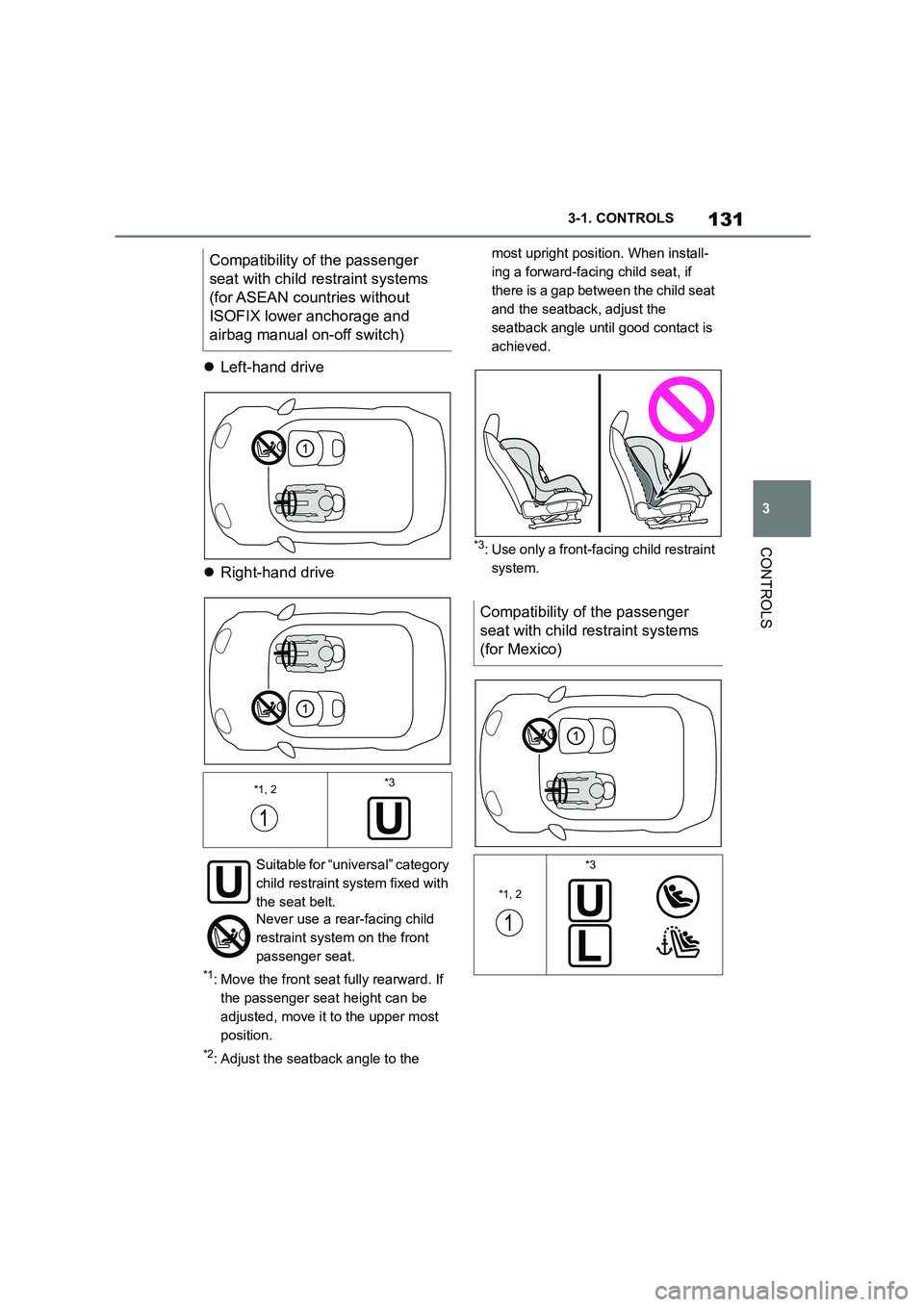
131
3
3-1. CONTROLS
CONTROLS
Left-hand drive
Right-hand drive
*1: Move the front seat fully rearward. If
the passenger seat height can be
adjusted, move it to the upper most
position.
*2: Adjust the seatback angle to the
most upright position. When install-
ing a forward-facing child seat, if
there is a gap between the child seat
and the seatback, adjust the
seatback angle until good contact is
achieved.
*3: Use only a front-fa cing child restraint
system.
Compatibility of the passenger
seat with child restraint systems
(for ASEAN countries without
ISOFIX lower anchorage and
airbag manual on-off switch)
*1, 2*3
Suitable for “universal” category
child restraint syst em fixed with
the seat belt.
Never use a rear-facing child
restraint system on the front
passenger seat.
Compatibility of the passenger
seat with child restraint systems
(for Mexico)
*1, 2
*3
Page 134 of 498
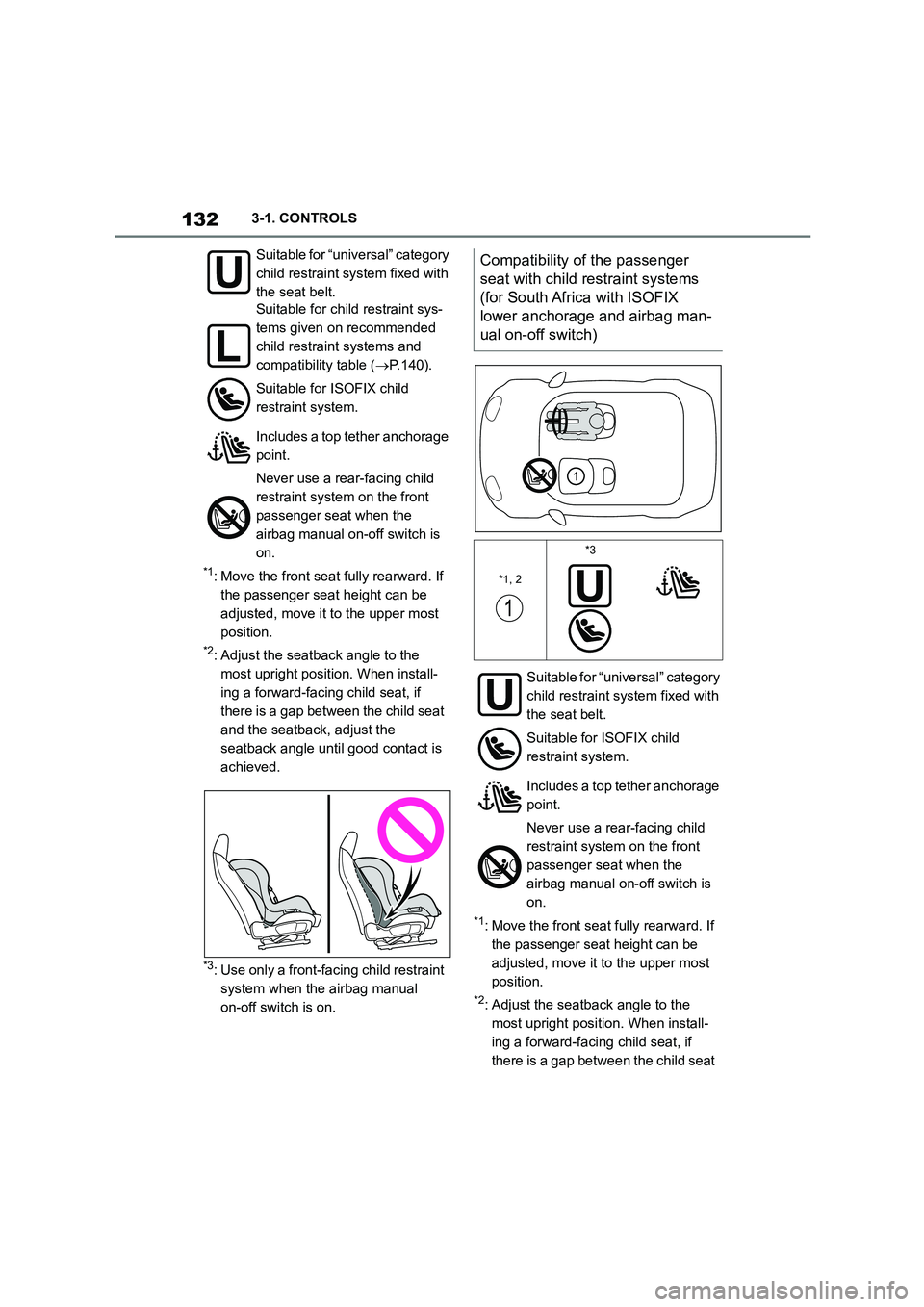
1323-1. CONTROLS
*1: Move the front seat fully rearward. If
the passenger seat height can be
adjusted, move it to the upper most
position.
*2: Adjust the seatback angle to the
most upright position. When install-
ing a forward-facing child seat, if
there is a gap between the child seat
and the seatback, adjust the
seatback angle until good contact is
achieved.
*3: Use only a front-facing child restraint
system when the airbag manual
on-off switch is on.
*1: Move the front seat fully rearward. If
the passenger seat height can be
adjusted, move it to the upper most
position.
*2: Adjust the seatback angle to the
most upright position. When install-
ing a forward-facing child seat, if
there is a gap between the child seat
Suitable for “universal” category
child restraint syst em fixed with
the seat belt.
Suitable for child restraint sys-
tems given on recommended
child restraint systems and
compatibility table ( P.140).
Suitable for ISOFIX child
restraint system.
Includes a top tether anchorage
point.
Never use a rear-facing child
restraint system on the front
passenger seat when the
airbag manual on-off switch is
on.
Compatibility of the passenger
seat with child restraint systems
(for South Africa with ISOFIX
lower anchorage and airbag man-
ual on-off switch)
*1, 2
*3
Suitable for “universal” category
child restraint system fixed with
the seat belt.
Suitable for ISOFIX child
restraint system.
Includes a top tether anchorage
point.
Never use a rear-facing child
restraint system on the front
passenger seat when the
airbag manual on-off switch is
on.
Page 135 of 498
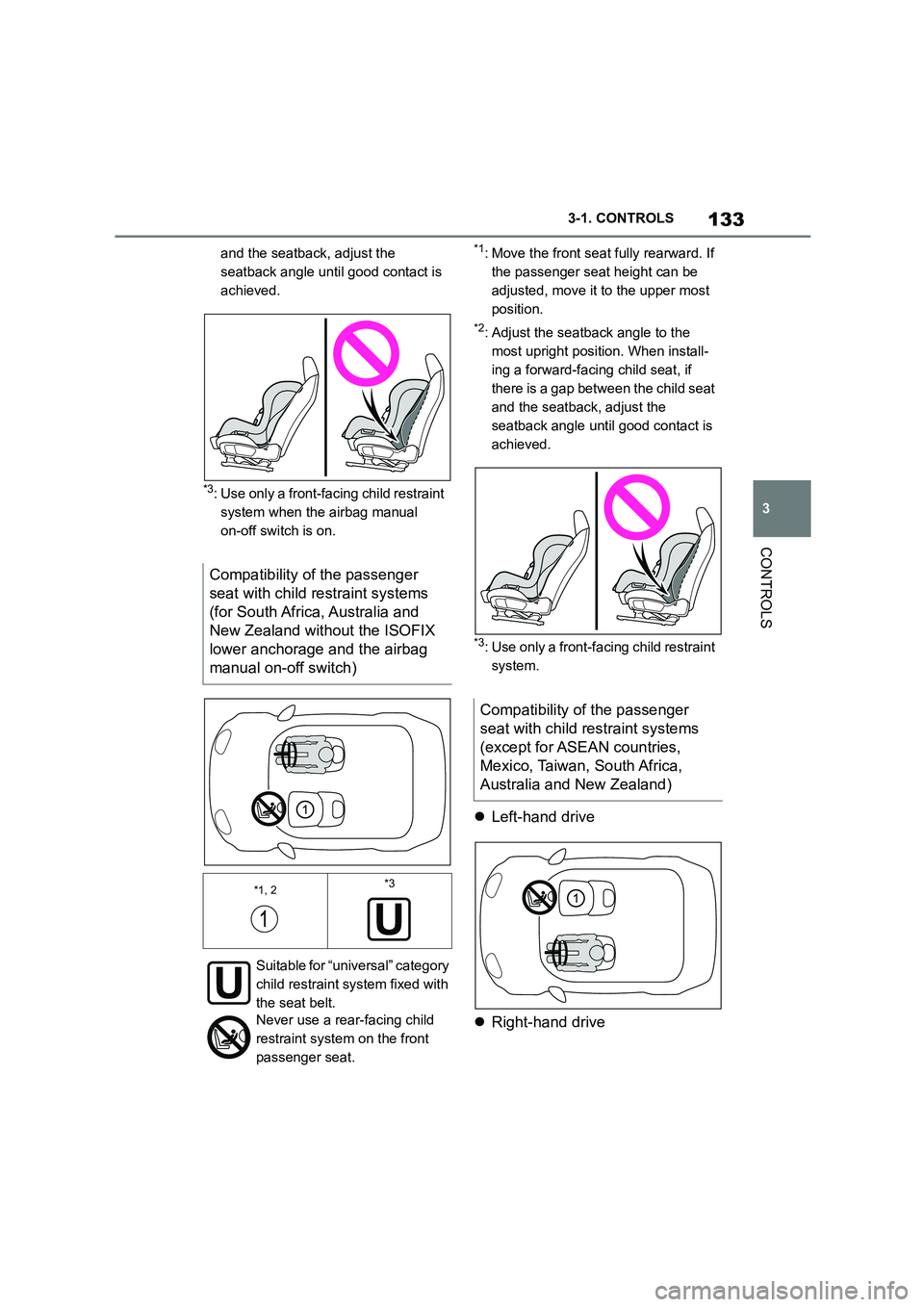
133
3
3-1. CONTROLS
CONTROLS
and the seatback, adjust the
seatback angle until good contact is
achieved.
*3: Use only a front-facing child restraint
system when the airbag manual
on-off switch is on.
*1: Move the front seat fully rearward. If
the passenger seat height can be
adjusted, move it to the upper most
position.
*2: Adjust the seatback angle to the
most upright position. When install-
ing a forward-facing child seat, if
there is a gap between the child seat
and the seatback, adjust the
seatback angle until good contact is
achieved.
*3: Use only a front-fa cing child restraint
system.
Left-hand drive
Right-hand drive
Compatibility of the passenger
seat with child restraint systems
(for South Africa, Australia and
New Zealand without the ISOFIX
lower anchorage and the airbag
manual on-off switch)
*1, 2*3
Suitable for “universal” category
child restraint syst em fixed with
the seat belt.
Never use a rear-facing child
restraint system on the front
passenger seat.
Compatibility of the passenger
seat with child restraint systems
(except for ASEAN countries,
Mexico, Taiwan, South Africa,
Australia and New Zealand)
Page 136 of 498
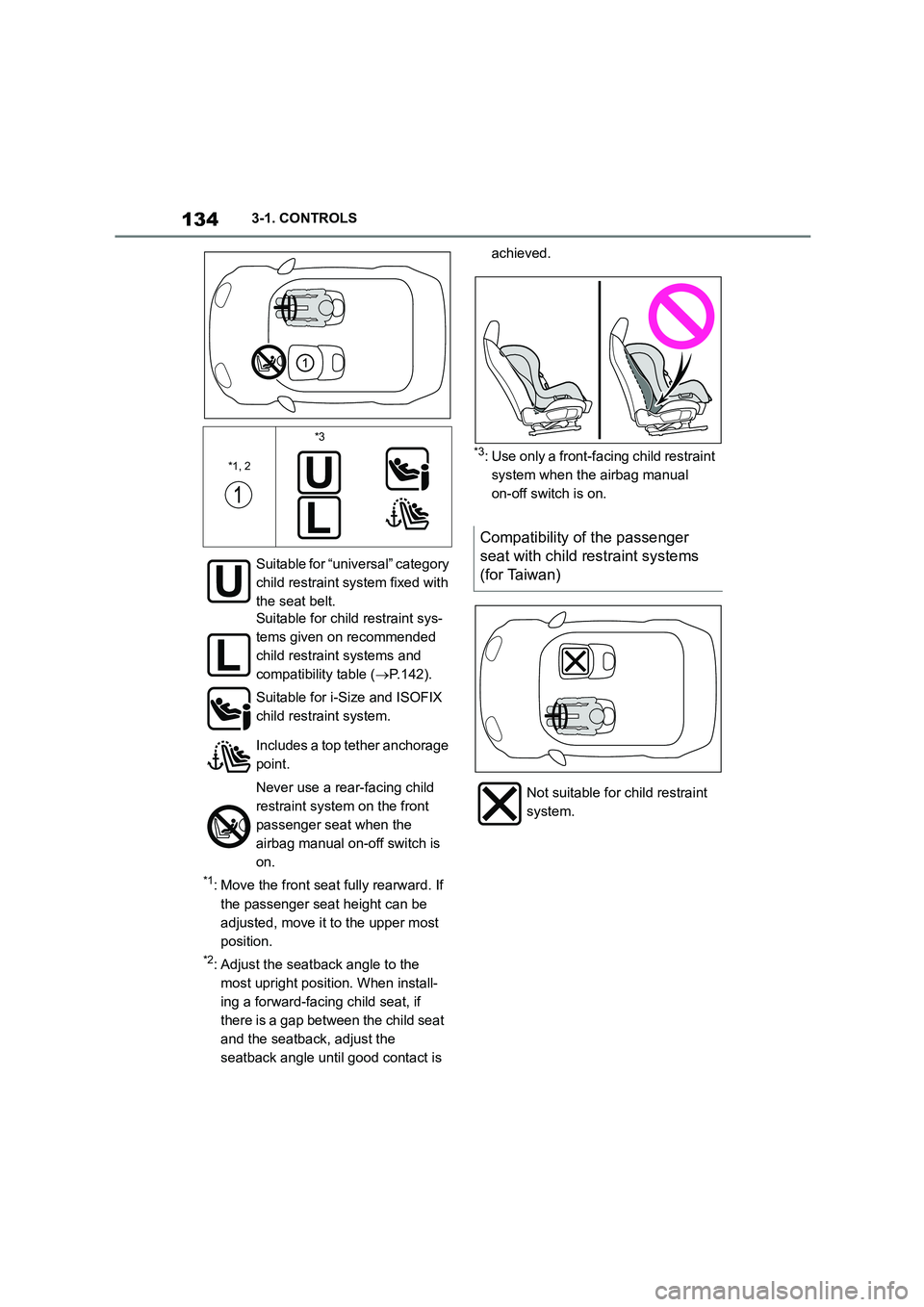
1343-1. CONTROLS
*1: Move the front seat fully rearward. If
the passenger seat height can be
adjusted, move it to the upper most
position.
*2: Adjust the seatback angle to the
most upright position. When install-
ing a forward-facing child seat, if
there is a gap between the child seat
and the seatback, adjust the
seatback angle until good contact is
achieved.
*3: Use only a front-fa cing child restraint
system when the airbag manual
on-off switch is on.
*1, 2
*3
Suitable for “universal” category
child restraint syst em fixed with
the seat belt.
Suitable for child restraint sys-
tems given on recommended
child restraint systems and
compatibility table ( P.142).
Suitable for i-Size and ISOFIX
child restraint system.
Includes a top tether anchorage
point.
Never use a rear-facing child
restraint system on the front
passenger seat when the
airbag manual on-off switch is
on.
Compatibility of the passenger
seat with child restraint systems
(for Taiwan)
Not suitable for child restraint
system.
Page 137 of 498
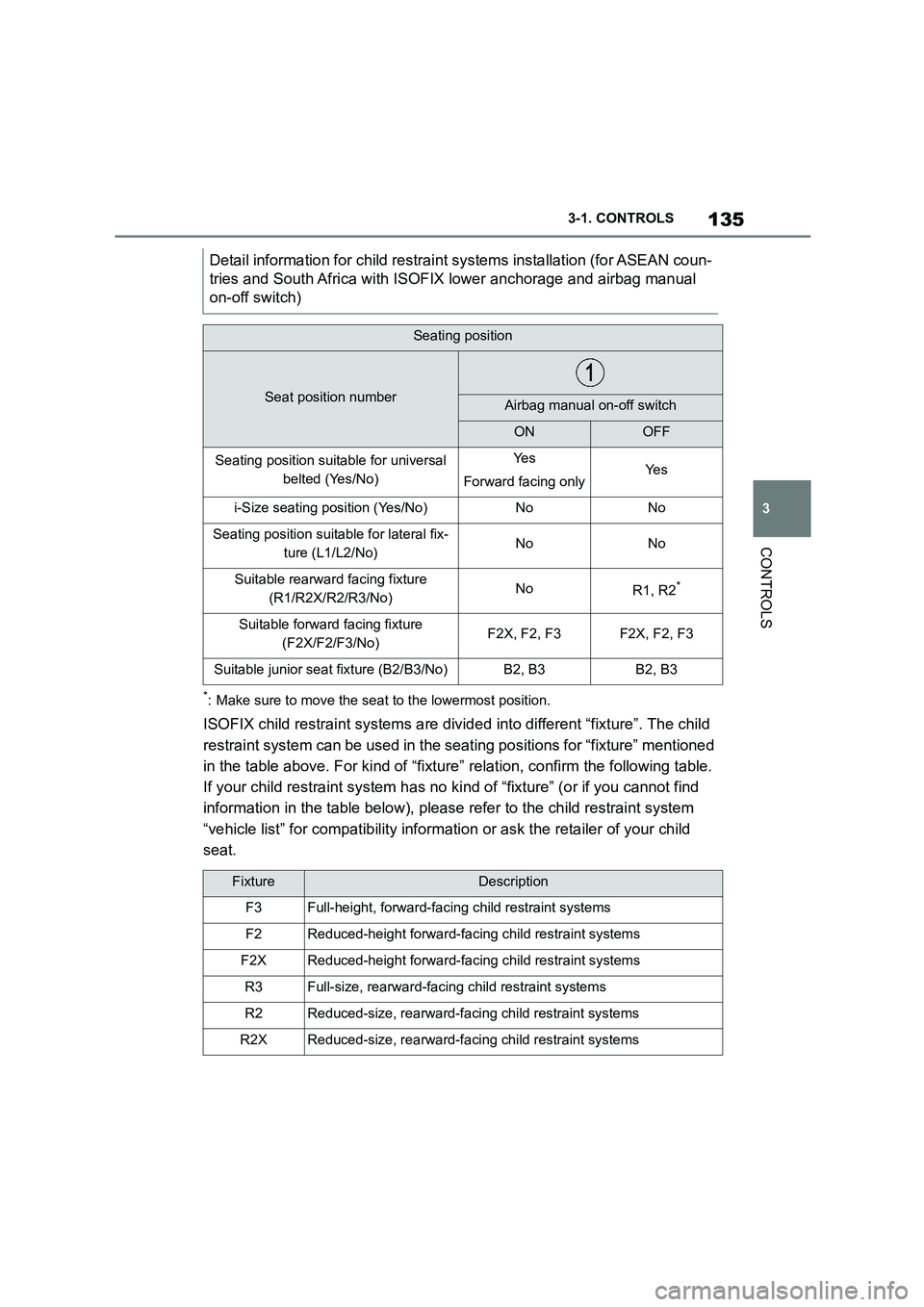
135
3
3-1. CONTROLS
CONTROLS
*: Make sure to move the seat to the lowermost position.
ISOFIX child restraint systems are divid ed into different “fixture”. The child
restraint system can be used in the se ating positions for “fixture” mentioned
in the table above. For kind of “fixtu re” relation, confirm the following table.
If your child restraint system has no ki nd of “fixture” (or if you cannot find
information in the table below), please refer to the child restraint system
“vehicle list” for compatib ility information or ask the retailer of your child
seat.
Detail information for chil d restraint systems installation (for ASEAN coun-
tries and South Africa with ISOFIX lower anchorage and airbag manual
on-off switch)
Seating position
Seat position numberAirbag manual on-off switch
ONOFF
Seating position suitable for universal
belted (Yes/No)
Ye s
Forward facing onlyYe s
i-Size seating position (Yes/No)NoNo
Seating position suitable for lateral fix-
ture (L1/L2/No)NoNo
Suitable rearward facing fixture
(R1/R2X/R2/R3/No)NoR1, R2*
Suitable forward facing fixture
(F2X/F2/F3/No)F2X, F2, F3F2X, F2, F3
Suitable junior seat fixture (B2/B3/No)B2, B3B2, B3
FixtureDescription
F3Full-height, forward-faci ng child restraint systems
F2Reduced-height forward-facing child restraint systems
F2XReduced-height forward-facing child restraint systems
R3Full-size, rearward-facing child restraint systems
R2Reduced-size, rearward-facing child restraint systems
R2XReduced-size, rearward-facing child restraint systems
Page 138 of 498
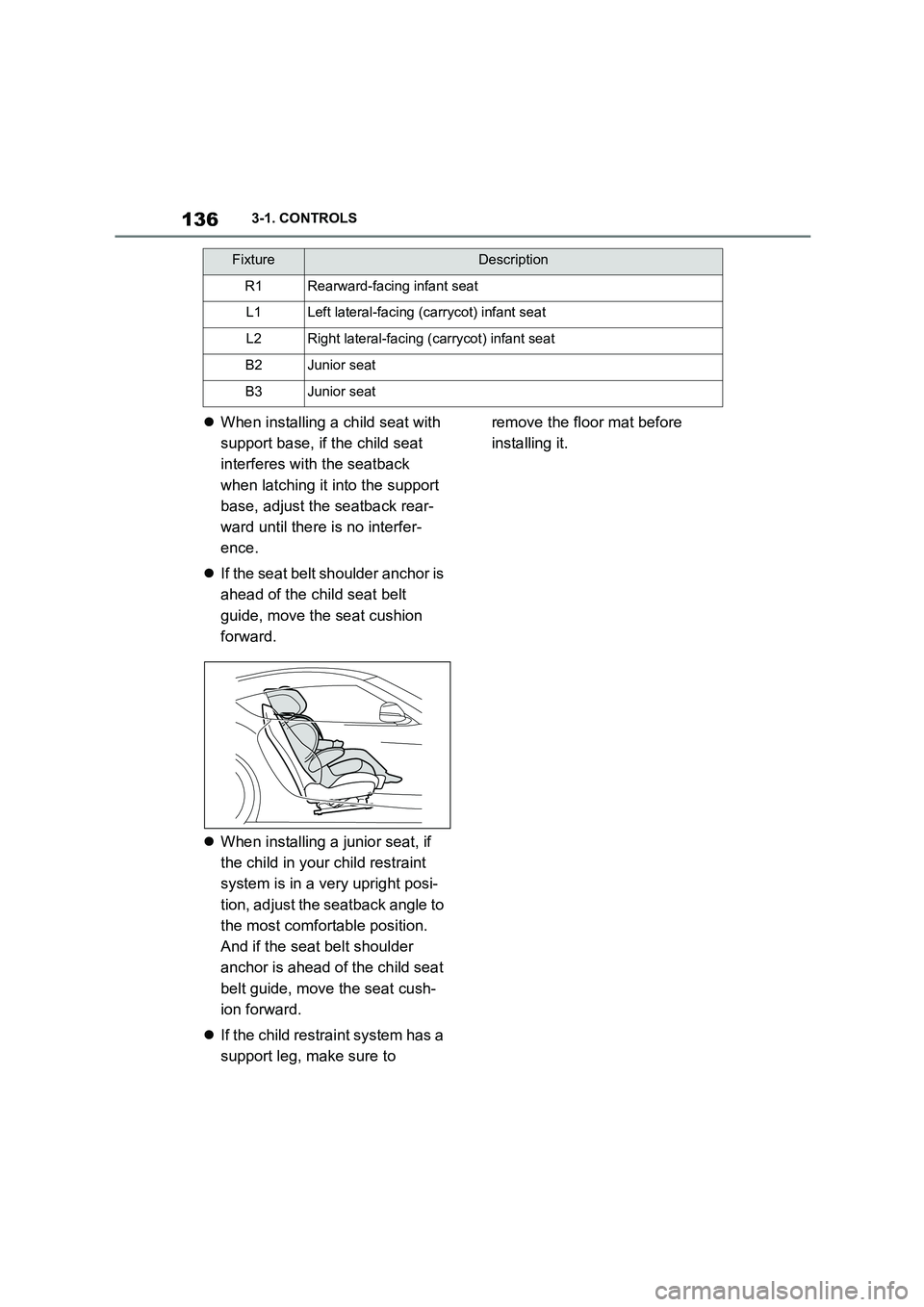
1363-1. CONTROLS
When installing a child seat with
support base, if the child seat
interferes with the seatback
when latching it into the support
base, adjust the seatback rear-
ward until there is no interfer-
ence.
If the seat belt shoulder anchor is
ahead of the child seat belt
guide, move the seat cushion
forward.
When installing a junior seat, if
the child in your child restraint
system is in a very upright posi-
tion, adjust the seatback angle to
the most comfortable position.
And if the seat belt shoulder
anchor is ahead of the child seat
belt guide, move the seat cush-
ion forward.
If the child restraint system has a
support leg, make sure to
remove the floor mat before
installing it.
R1Rearward-facing infant seat
L1Left lateral-facing (carrycot) infant seat
L2Right lateral-facing (carrycot) infant seat
B2Junior seat
B3Junior seat
FixtureDescription
Page 139 of 498
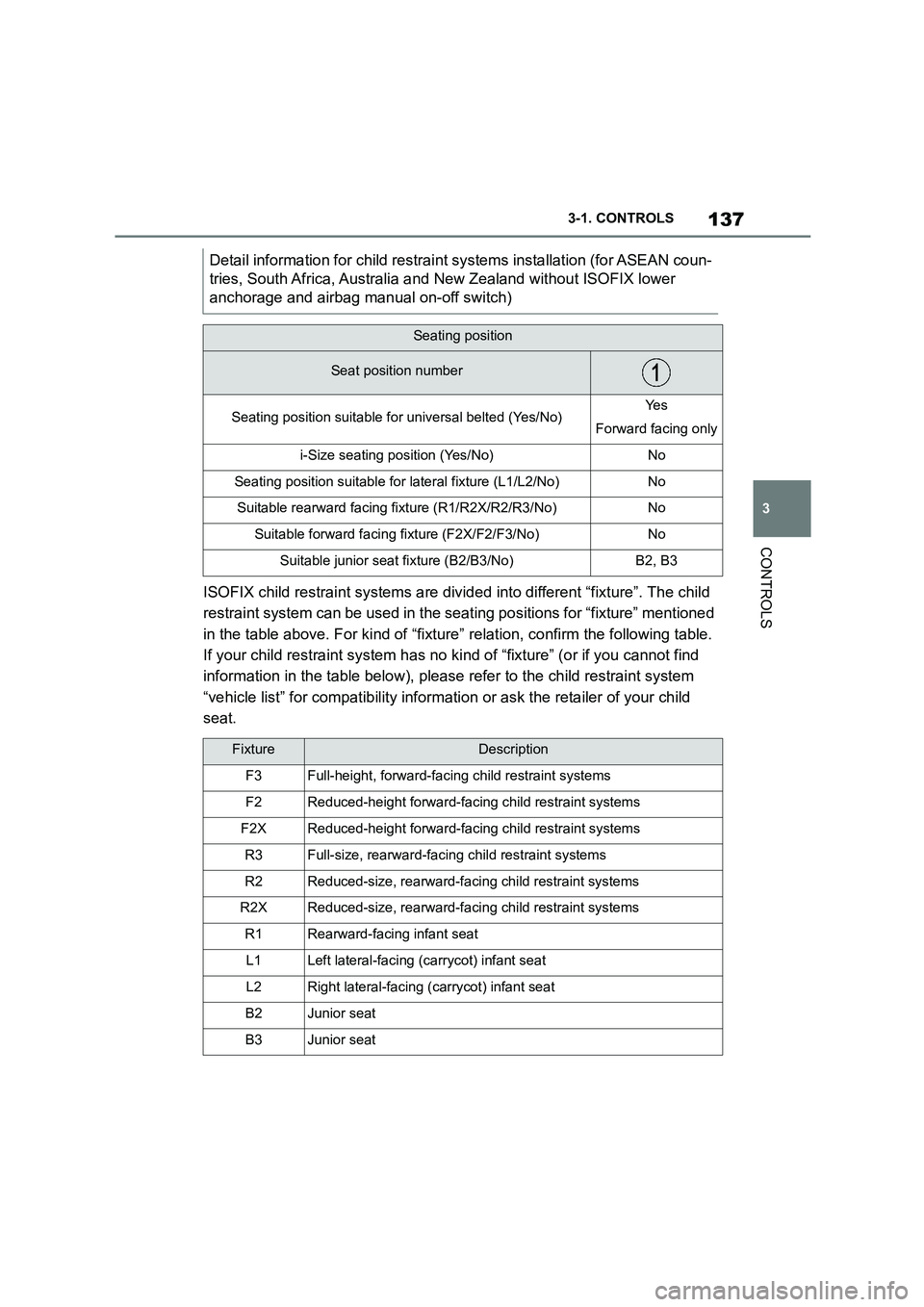
137
3
3-1. CONTROLS
CONTROLS
ISOFIX child restraint systems are divid ed into different “fixture”. The child
restraint system can be used in the se ating positions for “fixture” mentioned
in the table above. For kind of “fixtu re” relation, confirm the following table.
If your child restraint system has no ki nd of “fixture” (or if you cannot find
information in the table below), please refer to the child restraint system
“vehicle list” for compatib ility information or ask the retailer of your child
seat.
Detail information for chil d restraint systems installation (for ASEAN coun-
tries, South Africa, Australia and New Zealand without ISOFIX lower
anchorage and airbag manual on-off switch)
Seating position
Seat position number
Seating position suitable for universal belted (Yes/No)Ye s
Forward facing only
i-Size seating position (Yes/No)No
Seating position suitable for lateral fixture (L1/L2/No)No
Suitable rearward facing fixture (R1/R2X/R2/R3/No)No
Suitable forward facing fixture (F2X/F2/F3/No)No
Suitable junior seat fixture (B2/B3/No)B2, B3
FixtureDescription
F3Full-height, forward-faci ng child restraint systems
F2Reduced-height forward-facing child restraint systems
F2XReduced-height forward-facing child restraint systems
R3Full-size, rearward-facing child restraint systems
R2Reduced-size, rearward-facing child restraint systems
R2XReduced-size, rearward-facing child restraint systems
R1Rearward-facing infant seat
L1Left lateral-facing (carrycot) infant seat
L2Right lateral-facing (carrycot) infant seat
B2Junior seat
B3Junior seat
Page 140 of 498
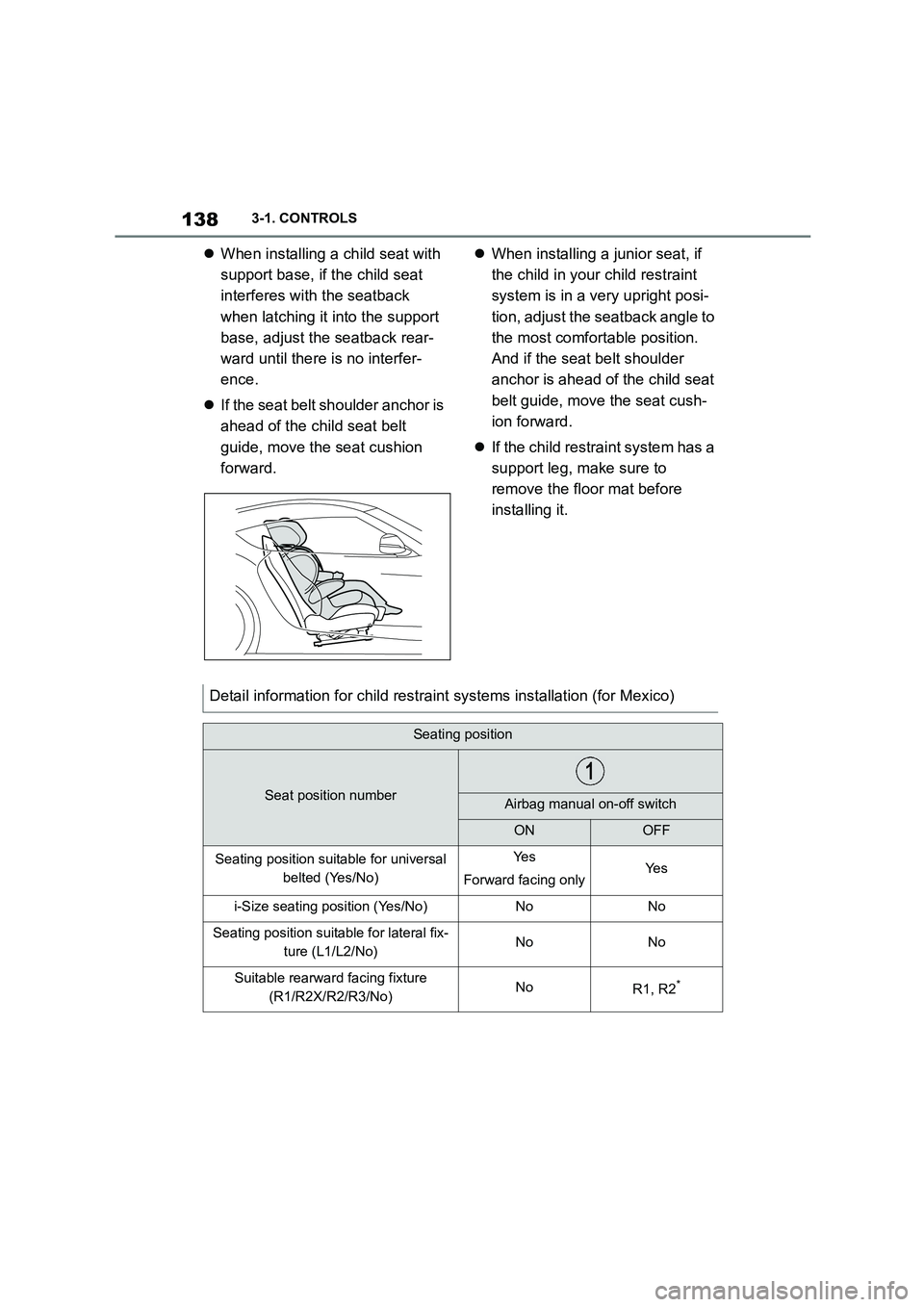
1383-1. CONTROLS
When installing a child seat with
support base, if the child seat
interferes with the seatback
when latching it into the support
base, adjust the seatback rear-
ward until there is no interfer-
ence.
If the seat belt shoulder anchor is
ahead of the child seat belt
guide, move the seat cushion
forward.
When installing a junior seat, if
the child in your child restraint
system is in a very upright posi-
tion, adjust the seatback angle to
the most comfortable position.
And if the seat belt shoulder
anchor is ahead of the child seat
belt guide, move the seat cush-
ion forward.
If the child restraint system has a
support leg, make sure to
remove the floor mat before
installing it.
Detail information for child restraint systems installation (for Mexico)
Seating position
Seat position numberAirbag manual on-off switch
ONOFF
Seating position suitable for universal
belted (Yes/No)
Ye s
Forward facing onlyYe s
i-Size seating position (Yes/No)NoNo
Seating position suitable for lateral fix-
ture (L1/L2/No)NoNo
Suitable rearward facing fixture
(R1/R2X/R2/R3/No)NoR1, R2*